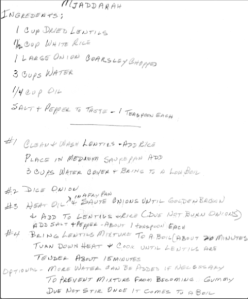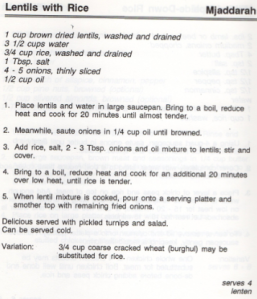Finally it ceased to snow. We were creeping into March now, where the whether is exponentially warmer and the flowers come out. The sun warmed the skin on my back, birds who seemed to have disappeared were back chirping louder than ever, not to mention summer must have been right around the corner. Spring was a time of utter joy in Salt Lake City. And a time for Mjaddarah.
But as us humans often say, nothing is perfect – kind of like the appearance of Mjaddarah ( shju-du-(d)rah). On sunday morning when it is still cold and my comfy, soft, warm bed is impossible to part from, mom was there to nuzzle me out for church at 8 AM. We would learn the Old Testament and New every week at my grade school. My great Aunt Jane who helped raise me went to church every sunday. And when we had family reunions with my grandma’s six sisters and all of their offspring, I was surrounded by catholics. Growing up, there was no skipping church on sunday.
Some advantages were held to being catholic. One had to do with the delicious meals Aunt Jane would make. Lebanese dishes on Lebanese dishes were made throughout my childhood, and I have to say, they were much better than your average American food. Not to mention the crazy weddings we hold, but that’s another story for a different day. Do you know how big the US army is? The answer is roughly 600,000 people. Every time Aunt Jane cooks, she cooks for an army, whether my brother and I have five friends, just my family is sitting at the table, or my five billion first, second, third, fourth, fifth, fourth twice removed… I have a lot of close cousins.
The most memorable times of Aunt Jane’s cooking, however, came when just my brother and I, and generally a couple friends were around in the Spring time. Lent always comes in the Spring, and is a time of fasting for catholics. When I say fasting I mean we don’t eat meat on Friday’s. Be not struck with fear, this is where Mjaddarah comes in, providing all the protein and essential goodies one needs. So on Friday’s when we finished school at 12:15 and the new Spring sunshine awaited, Mjaddarah would be waiting for us on the stove in a large pot; fit for two armies. The plan was simple: fuel up with Mjarddarah, and proceed to the front yard for some good old fashioned football. When Mjarddarah and football are in the same sentence, thats the part of american culture I love.
Nothing was more frightening than playing football with the fifth graders at recess. They were bigger, stronger, louder, and fiercer than us fourth graders. One year made the biggest difference at that age. Jake lived behind me and we had hung out plenty of times; playing Fifa on playstation, creating tin foil boats for when it poured rain, or even driving to the hospital after a formidable game of frisbee. But his friend Jackson I didn’t know. So when he came over after school one friday, I wasn’t too sure.
A nice big bowl of Mjaddarah is a great dish to use when warming up to someone! It is not the best eye candy, nor is like anything most Americans have ever seen. When first placed on the table neither Jackson nor Jake were sure about the Majaddarah. And I wasn’t too sure about Jackson. Neither one of them should be judged by their cover.
Now I can’t really speak for Jackson, but when the first bite of Mjaddarah nests in the tongue, the soft, savory rice and lentils dwindle down in the mouth, and there is no looking back before the stomach has reached full capacity. Even then wanting more is not unusual. Jackson went from looking timidly at the Majaddarah to finishing off the entire amount Aunt Jane put out! After our first encounter it was impossible to keep him out of my house. We became good friends and still talk to this day.
“Muslim, Christian and Jewish families of the Middle East all savor it, and there are versions of it with South Indian and other spices. It is endlessly versatile.”http://open.salon.com/blog/emma_peel/2009/02/10/mjaddarah_lentils_caramelized_onions_and_rice
While catholics aren’t the only people in the Middle East who savor Mjaddarah, I will describe some unique ways my aunt made the recipe. I have a few of my own personal ways even, one in which I simply add greek yogurt. Everyone can personalize the recipe for themselves.
You know those days when you don’t feel like moving at all, but maybe sit in front of the TV or meander around the house all day long? Or maybe your feeling spicy and you want to go clubbin’ until the AM. My personal favorite way of eating Mjaddarah goes better with the first mood I mentioned. Lebanese, or Syrian bread, most often known as pita, is rather simple to find at most markets. Or you could be lucky like me and know someone who makes it, OG style. Either way, using your hands to wrap the Mjaddarah with a blanket of Lebanese bread provides a mouth-watering taste. It’s like a burrito, only safer, healthier, and more comforting.
If your feeling more up for the ladder situation, there is a way to eat Mjaddarah that fits the party life as well. We will use a fork this time, but still bring a compliment to the table. This extra can be done in different ways, but the general idea is using lettuce or coleslaw on top of the Mjaddarah. Aunt Jane uses a nice lemon and oil sauce on thin slices of lettuce. The sudden and provocative taste of lemon counteracting with the Mjaddarah suits most people quite nicely.
Like a marine without a gun, the taste of Mjaddarah on it’s own can be equally as dangerous; don’t be thinking the recipe needs additives. The meal will swoop an average joe of his feet with nothing but its unarmed self. This method can be recommended for any given day of the week.
I provided the recipe above in Aunt Jane’s hand writing. I will have to say the best way to make Mjaddarah is in the photo I took above, and if you click on the photo, it should blow up in another screen where you can easily read the recipe. If unable to figure this out, I have provided a very similar recipe below in typed writing from a recipe book called The Lebanese Kitchen. No promises this recipe is as good as Aunt Jane’s, so you’ll just have to do a little bit of work for the legendary, homemade version.



That is one of the most evocative opening lines! It catches the reader in some sort of mid-action which immediately pulls the reader into the essay. Nice touch. As you continue to work on this consider answering these questions: Can you describe how Majaddarah looks and tastes? It’s like X but nothing like Y can help an audience unfamiliar with the dish get a sense of what it might be like. Also remember to include outside facts.
1. Elimination of “to be” and “to have” – You’ve done a good job not using “to be” or “to have”. I can’t find an example of a sentence that needs revision.
2. Use of proper nouns – For the most part you stay away from common nouns. There are still some sentences that could use revision. Example: “Everyday at grade school we spent time learning religion”
3. Combining thoughs – I think you do a good job combing your thoughts without losing meaning. I can’t find an example of a sentence that needs revision.
4. I think the story is about your memories with Mjaddarah and how the dish made the situations better.
5. Focus – Though your variety of memories with Mjaddarah is good, it’s not very focused. If the memories were connected and told a story, the essay would work. Also, why is this story worthwhile to readers who don’t know you? Find a way to connect it to something beyond yourself.
Depth – What is the food issue that Mjaddarah is connected to in this essay? Maybe discuss how people won’t try food that doesn’t look like what they usually eat.